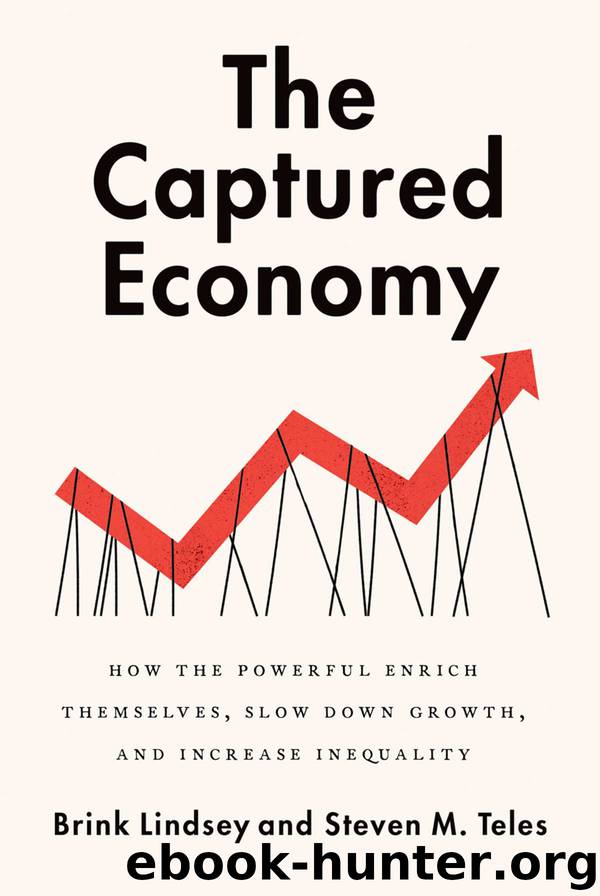The Captured Economy: How the Powerful Enrich Themselves, Slow Down Growth, and Increase Inequality by Brink Lindsey

Author:Brink Lindsey [Lindsey, Brink]
Language: eng
Format: epub, mobi
Publisher: Oxford University Press
Published: 0101-01-01T00:00:00+00:00
I THE STRANGLED URBAN HOUSING MARKET
Comprehensive controls on land use through zoning and other restrictions emerged in the United States early in the twentieth century and became endemic as the century progressed. The theoretical justification for zoning is that it coordinates orderly economic development and sanitary living conditions by geographically segregating conflicting and possibly incompatible land uses. What the common law of nuisance dealt with after the fact, zoning would prevent through prudent regulation.
In practice, the rise of zoning had little to do with the prevention of physical nuisances. Rather, the driving impetus was the protection of property values in neighborhoods of single-family homes from the threat of nearby nonconforming uses, whether in the form of industrial or commercial facilities or high-density apartments (and their poorer and darker residents). The suburbanization of America led to the zoning of America, with land-use controls operating as a kind of surrogate for home value insurance.1
From the beginning, zoning exerted a powerful influence on the location and character of housing supply within a given metropolitan area. That was the whole point. Up until around 1970, however, zoning does not appear to have affected the growth of aggregate housing supply across such areas. Housing may have been artificially restricted in some affluent suburbs, but more concentrated growth in development-friendly communities kept overall housing supply in the larger region responsive to growth in demand.
Harvard economist Edward Glaeser, together with colleagues, has led the way in amassing evidence of how things have changed since 1970. The first clue is the growing gap between house prices and construction costs. Between 1950 and 1970, house prices grew in line with construction costs; real house prices per square foot rose 35 percent over the period while inflation-adjusted construction costs per square foot increased by 28 percent. Between 1970 and 2000, by contrast, house prices shot up by 72 percent while construction costs actually declined by 3 percent. The divergence has been especially dramatic in America’s big coastal cities. While real construction costs in Boston and San Francisco rose by 6.6 percent and 5.6 percent, respectively, house prices shot up by 127 percent in Boston and 270 percent in San Francisco.2
Can improvements in the quality of new homes explain the gap? To investigate, Glaeser compared trends in home prices overall to trends in repeat sales (which hold home quality constant) and found that changes in quality can explain at most a quarter of the increase in house prices nationwide. In high-price cities, quality improvements have been even less of a factor.3
The next clue is that house prices rose relative to costs even as the rate of new construction has declined. Looking at a sample of 102 metropolitan areas, Glaeser found that the median rate of new construction (new homes divided by initial housing stock) fell from a robust 40 percent during the 1950s to only 14 percent during the 2000s. This decline has been especially dramatic in high-price coastal cities. In the 1950s, the housing stock grew by more than 20
Download
The Captured Economy: How the Powerful Enrich Themselves, Slow Down Growth, and Increase Inequality by Brink Lindsey.mobi
This site does not store any files on its server. We only index and link to content provided by other sites. Please contact the content providers to delete copyright contents if any and email us, we'll remove relevant links or contents immediately.
| Anthropology | Archaeology |
| Philosophy | Politics & Government |
| Social Sciences | Sociology |
| Women's Studies |
The Secret History by Donna Tartt(18151)
The Social Justice Warrior Handbook by Lisa De Pasquale(11950)
Thirteen Reasons Why by Jay Asher(8447)
This Is How You Lose Her by Junot Diaz(6430)
Weapons of Math Destruction by Cathy O'Neil(5825)
Zero to One by Peter Thiel(5487)
Beartown by Fredrik Backman(5348)
The Myth of the Strong Leader by Archie Brown(5236)
The Fire Next Time by James Baldwin(5015)
How Democracies Die by Steven Levitsky & Daniel Ziblatt(4950)
Promise Me, Dad by Joe Biden(4907)
Stone's Rules by Roger Stone(4852)
100 Deadly Skills by Clint Emerson(4684)
A Higher Loyalty: Truth, Lies, and Leadership by James Comey(4546)
Rise and Kill First by Ronen Bergman(4542)
Secrecy World by Jake Bernstein(4387)
The David Icke Guide to the Global Conspiracy (and how to end it) by David Icke(4376)
The Farm by Tom Rob Smith(4320)
The Doomsday Machine by Daniel Ellsberg(4241)
